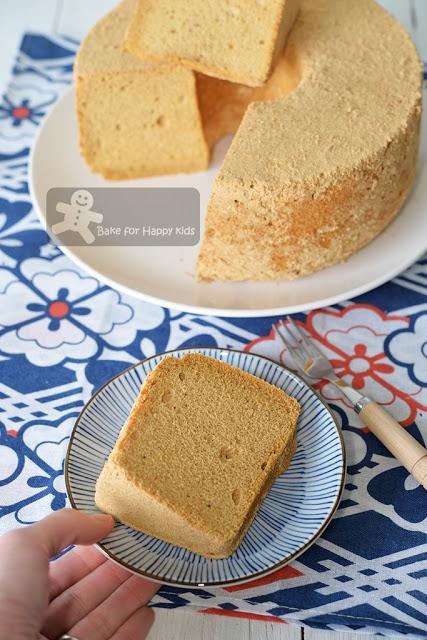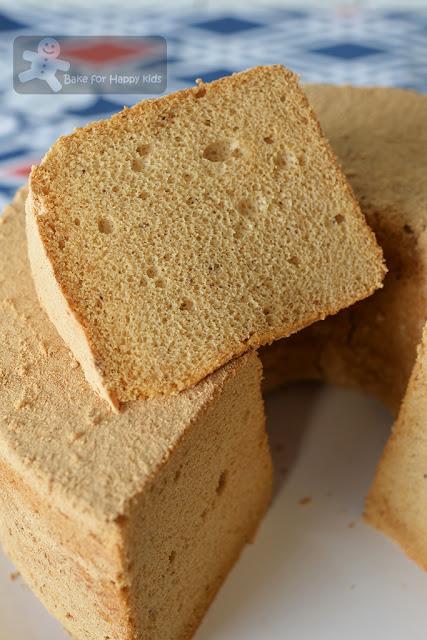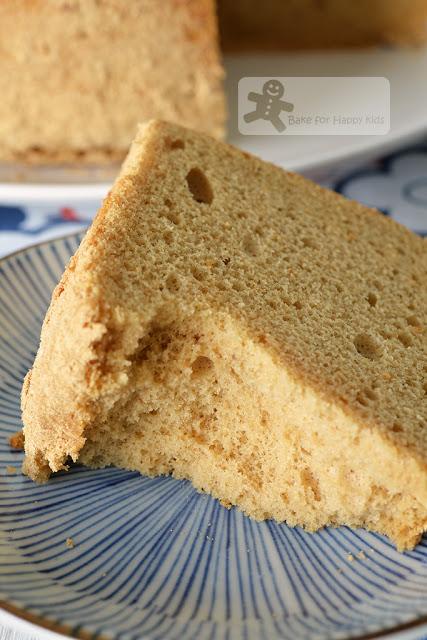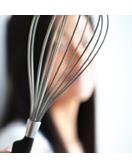I remember the ultra soft and moist Japanese mochi that we had at Nara. It was freshly made by two Japanese men bashing the sweet rice dough using two gigantic wooden hammer rod with a rhythm. The mochi were divided and shaped with red bean filling and coated with kinako.
Kinako? It is also roasted soybean flour (黄粉 or きなこ) which is commonly used in Japanese cuisine. Nutrition-wise, kinako is known to contain good amount of vitamins, mineral and proteins. And taste-wise, it is an unique tasting ingredient that can add warm nutty flavor and fragrance to compliment Japanese sweets like mochi and other wagashi.
With this concept, I wonder...
Can I do the same to create ultra soft kinako chiffon cake?
Sure, I can! And I'm not the only one who had thought of this idea. I did a Google search for "kinako chiffon cake" and found a few recipes which are mostly adapted from the book, Okashi by Keiko Ishida but for some reasons, I don't really like this specific recipe. Maybe because I'm too fussy? I actually want to bake a chiffon cake that is so soft that it reminisces the ultra soft kinako-coated mochi that I had.
And so the totally inspired me created this...

Proudly presenting my ultra soft and spongy Kinako (Roasted Soy Bean Flour) Chiffon Cake recipe!
Where can you buy kinako?
It's available at Amazon and many online shops including some that are located in Australia and Singapore.
If not, you can roast your own kinako from soybean flour which is commonly available in most health shops and Asian grocery shops and some supermarkets. To do that, you will have cook soybean flour in a frying pan until the flour darkens into a tan color. It will smells like popcorn and has a warm nutty flavor. There you go... you have made kinako!
No worries! I have a video to show how I roasted my soybean flour and used the roasted soybean flour to bake an ultra soft kinako chiffon cake. Easy peasy!
Thanks Bensound for the music in my video.
Any baking tips?
Yes! If you are roasting the soybean flour, you have to stir and cook the soybean flour at low heat. At any stage, you must be alert and prepared to remove your frying pan from the heat as the flour tends to darken too quickly.
And as usual, the chiffon cake baking tips are the same as the ones that I mentioned at my previous milk chiffon cake post at here.
Any questions?
Some of you might notice and want to ask... Why did I wrap my chiffon cake pan with foil?
I was exploring several ways to bake ultra soft and sensitive chiffon cakes with the least amount of cracks and these are a few strategies that I have tried:
1) Place an empty baking tray placed at the highest position in the oven as a heat shield
2) Wrap chiffon cake pan with 2-3 layers of foil to insulate the cake from any excessive heating
I reckon that this can help to certain extent but it is not absolutely necessary - as shown in this video.
3) Knowing my oven and its temperature setting
4) Baking with steam
The details of point (3) and (4) have been extensively discussed at here before. Please read my blog post, How to bake an Ultra Soft Pandan Chiffon Cake with Less Cracks? at here if you are interested.
All I have to say is I strongly don't prefer to bake my chiffon cake with steam.
Is baking a flawless crackless chiffon cake too complicated for you?
Then don't bother! It is totally ok if your chiffon cakes have cracks! The softness of the cake won't change even if you bake them in a typical oven setting 160°C / 320ºF for 50 mins (for a typical 20 cm cake). To me, what really matters is actually the recipe!!! Ultimately, I believe that it is the composite of the cake that will eventually determine its softness and yumminess. Agree?

Great well risen texture!
Despite having some cracks on my cake, it is still good with soft cottony texture!

To me, it is the recipe that determine the ultimate softness and taste.
And this cake is so soft that it reminisces the ultra soft kinako-coated mochi that I had.
Like this ultra soft chiffon cake and want more? I have shared many ultra soft chiffon cakes at here (banana chiffon cake), here (honey chiffon cake), here (cranberry yogurt chiffon cake), here (cocoa chocolate chiffon cake), here (milk chiffon cake), here (pandan chiffon cake with milk) and here (orange chiffon cake). And if you are after more ultra soft chiffon cake recipes in the near future, I have lots to share and so please stay tune!
To get the latest updates, you can follow me at either my Facebook at here or here or my Instagram @zoebakeforhappykids
I can't believe that it is about a year ago that we were in Nara and Osaka. Hmmm... It's time for us to go for another holiday again. Yay!!!
For the next 2 weeks, we are going to Singapore and Bangkok. If you wish to "come along" with us to see what we will do at Singapore and Bangkok, please follow me at my Instagram @zoebakeforhappykids Otherwise, I'm be back soon for my Christmas baking.
Here's my recipe.
IMPORTANT: Please use the exact weight and make sure that all ingredients are at room temperature.
Makes one tall and perfect 8-inch (20 cm) chiffon cake
To roast soy flour:
75g (1/2 cup) or more soy flour as the flour might lose its weight slightly after roasting
For the egg yolks mixture:
50g vegetable oil
100g soy milk, lightly or not sweetened
40g dark brown sugar
75g all purpose / plain flour
25g cornflour
30g kinako (roasted soy flour)
1/4 tsp salt
For the egg white mixture:
210g egg whites (about 6)100g caster sugar
Preheat oven to 160°C/320ºF or please see my baking tips at here if you want to optimise your oven temperature setting further.
To roast soy flour:
Place soy flour in a frying pan and heat it over low heat with constant stirring. Cook for about 5 mins or until the flour become fragrant with a popcorn-like nutty smell and its color darken to tan. The flour can darken very quickly and so please keep stirring and monitor the cooking process carefully. Remove from heat and set aside to cool completely.For the egg yolk mixture:
Using a hand whisk, combine egg yolks, oil and milk in a large mixing bowl until well combined. Add dark brown sugar and whisk until combined with no large clumps of brown sugar. Sift in flour, cornflour, kinako and salt and whisk gently until the batter is smooth and combined.For the egg white mixture:
Using an electric mixer with a whisk attachment, beat egg whites at the lowest speed for at least 10 mins to stabilise the mixture. Increase beating speed to the next higher speed. While beating, add sugar gradually. Increase beating speed to the next higher speed and continue to beat until stiff peaks form and the meringue should be smooth and glossy. Do not use too high beating speed to avoid large bubbles forming. Do not over beat the mixture.Using a hand whisk or a spatula, gently fold in the egg whites to the egg yolks mixture in 3-4 batches. It is ok to mix the 1st batch of egg white more vigorously into the egg yolk mixture but the subsequent portions must be folded in very gently. Make sure that most of the white is not visible after folding.
Pour batter into an un-greased 20 cm chiffon tube pan. Give the pan a gentle tap and use a skewer to draw a zigzag to remove air bubbles only on the surface in the batter. Bake for 50-55 mins or until it is thoroughly baked. Remove from oven and invert the cake immediately to cool on a wire rack. Allow the cake to cool completely in the pan before removing it from the pan.
Sift the remaining kinako over the cake and coat the cake evenly with the sifted kinako. Pat and dust the cake to remove any excess kinako.
Slice and serve. The cake is fragile and so it is easier to slice with a serrated knife.
Store any uneaten in an airtight container at room temperature for up to 3 days.
Happy BakingPlease support me and like me at Facebook...

